Coffs Harbour rocked by fresh varroa mite detection
A spot of good news for Coffs Harbour’s busy little pollinators comes with a sting in the tail - a fresh detection of the calamitous and parasitic varroa mite on the city’s doorstep. Find out more.

Coffs Harbour
Don't miss out on the headlines from Coffs Harbour. Followed categories will be added to My News.
A fresh detection of the calamitous varroa mite has been found in beehives at Barcoogere north of Coffs Harbour, sparking a move to bolster crucial natives which are essentially immune to the parasite.
The detection of the mite - also known as varroa destructor - was brought to light by NSW Department of Primary Industries (DPI) tracing. It has centred on an area close to an existing Nana Glen purple (monitor) zone.
As a result of the invasion of the insect that attacks and feeds on honey bees, the DPI has immediately established Eradication Emergency (red) and Surveillance Emergency (purple) zones around the sites, under a new Biosecurity Emergency Order made on Sunday.
Lab results over the weekend have also uncovered nine new infested premises in the problematic Kempsey cluster.
Australia’s status as a chemical-free producer of honey hangs in the balance, with 264 infected premises now pinpointed in NSW.

News of a second varroa mite detection in the Coffs Harbour region tempers hive-fives all-round over moves to relocate native beehives in the area.
The Coffs Harbour highway bypass team, in co-operation with Clarence Native Bees, has just completed its 12th rescue of logs containing stingless native bees.
These hives found in the path of the bypass will - where suitable - be relocated to school grounds or with community groups in the City of Coffs Harbour local government area.
Clarence Native Bees coordinator Bob Moulds said he had taken care of a log hive rescued in June.

“They (the bees) are now active, and the log hive has now been handed over to Barcoo Community Gardens at Toormina where it will find its forever home,” he said.
“The first log, rescued in March 2022, was cared for by Clarence Native Bees and handed over to Bishop Druitt College in Middle Boambee in September last year.”
Native stingless bees are not susceptible to the varroa mite.
A Transport for NSW spokesperson said “these stingless bees provide millions, perhaps billions, of dollars’ worth of benefits to agriculture and forestry through pollination, so keeping as many of these colonies as healthy as possible is a great outcome”.
“This is particularly important with the outbreak of varroa mite in the region and the restriction of movement of European honey bees,” they said.
Varroa mite is an exotic deadly parasite which has spread to all inhabited continents, with Australia now at threat.
The varroa mite weakens bees, shortens their lives, or causes death from viral infections that otherwise would cause little harm.
Heavy varroa mite infestation causes crippled and crawling bees, a reduction in bee populations and ultimately colony breakdown and deaths of hives.
If you detect varroa mites, phone the Exotic Plant Pest Hotline on 1800 084 881, 9am to 5pm, Monday to Friday.




